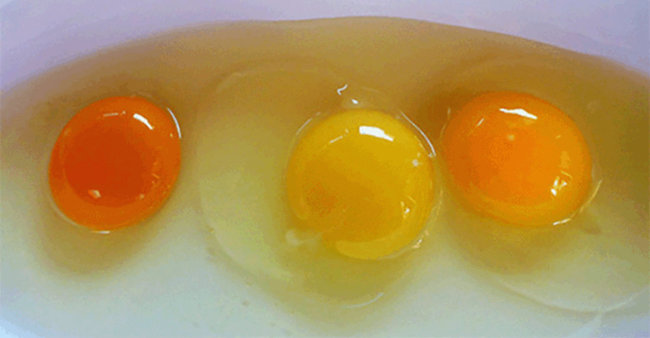When you cracked that egg into the frying pan this morning, you probably saw a quivering yellow yolk surrounded by translucent whites. What you probably didn't know is that eggs yolks aren't actually supposed to be yellow.
The color of an egg yolk says a lot about the health of the chicken who laid it, and for most of our breakfasts, the diagnosis is less than ideal.
When we think of egg-laying chickens, most of us picture a free-roaming, peck-where-she-pleases hen like the one pictured above. However, most eggs come from chickens who spend 24 hours a day cooped up in a cage. They rarely see the sun, and almost never roam. Want to know if your chicken was a prisoner or a roamer? Just look at the yolk.
Which one of these yolks looks normal to you?
If you buy your eggs in an American grocery store, the lighter-yellow yolk in the middle probably looks the most normal. Organic, vegetarian-fed or cheap; most commercially available eggs in the US have a thin, yellow yolk. And that means the chicken probably wasn't eating a healthy diet.
Although it may look unusual, a thick yolk with dark orange coloring is actually the most desirable.
"Richer-colored egg yolks are more likely to come from free-range hens," says Dr. Hilary Shallo Thesmar, director of food safety programs for the Egg Nutrition Center (ENC): "Free-range hens have the opportunity to eat more pigmented foods, and the pigment is then transferred to the yolk."
So why care about what the hen was eating? Because it affects the nutritional value of the egg YOU'RE eating.
While macronutrients (protein and fat) remain the same regardless of yolk color, darker colored yolks indicate the presence of xanthophylls and omega-3 fatty acids in the hen's diet. Xanthophylls are found in dark leafy greens like spinach, kale and collards, as well as in zucchini, broccoli, and brussels sprouts. Omega-3 fatty acids are highly concentrated in flax seeds and sea kelp.
When these healthful nutrients are part of the hen's diet, the nutrients they are passed on to their eggs and concentrated in their yolks. And guess who eats those?! According to Mother Earth News, which conducted its own egg analysis, and a more recent Pennsylvania State University study, pastured eggs contain higher levels of vitamins A, D and E; more beta-carotene; and more omega-3s.
All this means is that a pastured egg is actually better for you, as well as the chicken who lays it. Find pastured eggs sold near you at LocalHarvest.org/pastured-eggs.jsp.
Fuente: distractify.com
